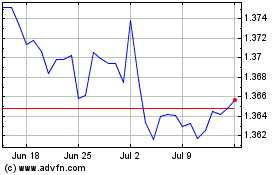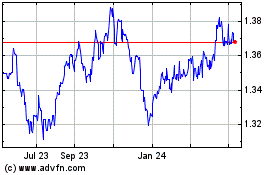U.S. Dollar Slides On Recession Worries
August 14 2019 - 4:35AM
RTTF2
The U.S. dollar declined against its major counterparts in the
European session on Wednesday, as the yield on 10-year treasury
bonds has dropped below the rate on the 2-year equivalent, in a
sign of an upcoming recession.
The difference between longer-dated and shorter-dated U.S. bond
yields widened by 1 basis point for the first time since 2007.
The inversion of the U.S. yield curve is seen as an indicator of
recession.
The move suggested mounting worries about the global economy as
investors sought safe haven assets.
European shares fell as weak data from China and Germany
overshadowed investor optimism over a temporary U.S.-China tariff
truce.
A slew of Chinese economic data surprised to the downside in
July while German GDP shrank 0.1 percent sequentially in the second
quarter, raising concerns about the state of the global
economy.
The currency was modestly higher in the previous session, as
Washington delayed its plan to impose tariffs on certain Chinese
goods from the proposed September 1 date.
The greenback depreciated to 105.78 against the yen, from a high
of 106.77 hit at 5:00 pm ET. The greenback is seen finding support
around the 104.00 level.
Having climbed to a 6-day high of 0.9770 against the franc at
12:45 am ET, the greenback reversed direction with the pair trading
at 0.9711. The greenback is poised to find support around the 0.95
level.
The greenback slipped to 1.1189 against the euro, from a 2-day
high of 1.1165 seen at 2:30 am ET. Next likely support for the
greenback is seen around the 1.13 level.
Flash estimate from Eurostat showed that Eurozone economic
growth halved in the second quarter, as initially estimated.
Gross domestic product grew 0.2 percent sequentially, following
the first quarter's 0.4 percent expansion.
The greenback edged down to 1.2100 against the pound from
Tuesday's closing value of 1.2058. If the greenback falls further,
1.22 is seen as its next support level.
Data from the Office for National Statistics showed that UK
consumer price inflation accelerated unexpected in July, exceeding
the central bank's 2 percent target.
Consumer prices climbed 2.1 percent year-on-year in July, faster
than the 2 percent increase in June. Inflation was forecast to slow
to 1.9 percent.
On the flip side, the greenback gained to 0.6425 against the
kiwi from its early low of 0.6469. On the upside, 0.62 is possibly
seen as the next resistance level for the greenback.
The greenback appreciated to a 6-day high of 1.3299 against the
loonie and a weekly high of 0.6743 against the aussie from
yesterday's closing quotes of 1.3223 and 0.6796, respectively. The
next possible resistance for the greenback is seen around 1.35
against the loonie and 0.63 against the aussie.
The U.S. import and export price indices for July will be
featured in the New York session.
US Dollar vs CAD (FX:USDCAD)
Forex Chart
From Mar 2024 to Apr 2024

US Dollar vs CAD (FX:USDCAD)
Forex Chart
From Apr 2023 to Apr 2024
